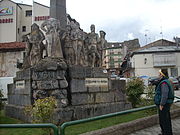| Juan Yagüe | |
|---|---|
| Birth name | Juan Yagüe Blanco |
| Born | 1891 |
| Died | October 9, 1952 |
| Place of birth | San Leonardo de Yagüe, Spain |
| Place of death | Burgos, Spain |
| Service/branch | Spanish Legion |
| Rank | Captain General |
| Commands held |
Military Commander of Melilla Captain General of the VI Military Region |
| Battles/wars |
Rif War Spanish Civil War |
| Awards | Military Medal |
Juan Yagüe y Blanco, 1st Marquis of San Leonardo de Yagüe (1891 – October 29, 1952) was a Spanish army officer during the Spanish Civil War, one of the most important in the National side. He became known as the “The Butcher of Badajoz” because he ordered thousands killed, including wounded men in the hospital.
Early life[]
The son of a doctor, he enrolled at a young age in the Infantry Academy of Toledo, where Francisco Franco was a fellow cadet. The two men received their commissions concurrently and served together in Africa, where Yagüe was wounded on several occasions and received several decorations.
Yagüe was promoted to lieutenant colonel in 1932. He, along with Franco and General López Ochoa, helped suppress a workers uprising in Asturias using Moroccan Regulars and Legionnaires in 1934. He was a strong early supporter of the Falange Española and a close personal friend of José Antonio Primo de Rivera.
Spanish Civil War[]
When Niceto Alcalá-Zamora was replaced as President of the Republic by the left-wing Manuel Azaña on May 10, 1936, a group of Spanish Army officers, including Yagüe, Emilio Mola, Franco, Gonzalo Queipo de Llano and José Sanjurjo, started plotting to overthrow the democratically elected Popular Front government. This led to a military uprising which precipitated the Spanish Civil War on July 17, 1936.
Yagüe's forces revolted in Ceuta before crossing the Straits of Gibraltar to link up with Nationalist forces in Seville, led by Queipo de Llano. Yagüe advanced northward, first seizing Mérida before attacking Badajoz with 3,000 troops on August 14, 1936. Bitter street fighting took place when the Nationalists advanced into the city. Yagüe's forces eventually gained control of Badajoz, with both sides suffering heavy casualties.
Under Yagüe's direction thousands of prisoners and civilians, including women and children, were executed in Badajoz and buried in common graves, during the Badajoz massacre, in one of the biggest massacres by the Nationalists of the war. [1][2][3][4] Before leaving the city, Yagüe was asked by the American journalist John T. Whitaker about his reason for killing all those people (10% of the city's population) and he answered:[5]
"Of course that we have killed them. What did you suppose? Will I take 4,000 red prisoners with my column, having to advance against the clock? Or will I leave them in my rearguard so that Badajoz will be red another time?"
Yagüe was then promoted to colonel and afterwards advanced on Madrid, capturing Trujillo, Navalmoral de la Mata and Talavera de la Reina, but was unable to take the capital. He took part in the Aragon Offensive and seized control of Belchite, Caspe and Lérida. He also played a leading role in the Nationalist victory at the Battle of the Ebro. In May 1938, Yagüe was removed from his command and imprisoned for injudicious remarks he made in a speech at Burgos, critical of Franco. He was back at the front within weeks.
It has been said that he was the only commander of Spanish forces that the Condor Legion respected.[6] Yagüe never showed panic even when the enemy was close by, and was able to adjust battle plans quickly in order to suit changing circumstances (they hated Mola for his cautious approach).

Monument to Juan Yagüe
Post-war[]
After the collapse of the Second Spanish Republic in 1939, Yagüe was promoted to major-general and appointed as Minister of the Air Force by General Franco. He was made a lieutenant general in 1942 and was posthumously made commander-in-chief.
Notes[]
- ↑ Rafael Tenorio, Las matanzas de Badajoz (Spanish).
- ↑ Mario Neves (1986) "La matanza de Badajoz. Crónica de un testigo de uno de los episodios más tragicos de la guerra civil de España". Salamanca, Editora Regional de Extremadura.
- ↑ Jay Allen (30 of August, 1935) "Slaughter of 4000 at Badajoz, City of Horrors", Chicago Tribune.
- ↑ Robert Payne (1962) "The Civil War in Spain, 1936-1939". New York, Puttnam.
- ↑ John T. Whitaker (1943) "We cannot escape history". New York, Macmillan.
- ↑ Antony Beevor, "The Spanish Civil War"
The original article can be found at Juan Yagüe and the edit history here.